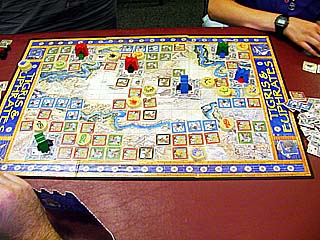Danger Planet open gaming. 4-player Zombies!!!, 2-player Magic: the Gathering, 4-player Tigres & Euphrates.
I took way too long to get to this session report, so I don't remember too much about it.
Players were Eric, Doug, James and myself.
We played the Quick Play Rules. We used my setup variant without reducing the tile count to 30.
Doug left early without scoring. It was certainly a quick game considering the town dead-ended so that no helipad came out. The Zombie Corps(e) tiles never came out; even so, it was fun to have the cards from the expansion in play.

The end-game
The game ended with James winning after 40 minutes of game time.
Zombies!!!: Click here to buy your own copy at FunAgain.com.
Zombie Corps(e) expansion: Click here to buy your own copy at FunAgain.com.
Players were James and myself.
I played this with James to kill some time before the next game. James provided both decks. I started out strong, but the decks were mana-weak and eventually James pulled out big creatures that killed me off quickly.
Players were Eric, Ralph, Cindy and myself. Ralph played this before.
We spent 25 minutes going over the rules. Winner is the player with the most victory points when: there are two or less treasures on the game board, or when a player cannot draw tiles to refresh their hand. The game board starts out with a fixed number of temples with treasure. Basically, tiles can be placed adjacent to other tiles. Pawns can be placed next to temples, creating a kingdom. A player scores a victory point of a particular color for a tile added to a kingdom with a pawn of that color if there's no conflict. (A black pawn can score tiles of other colors if pawns of the other colors are not in the kingdom.) An external conflict occurs when kingdoms are joined. This is resolved by the number of each specific tile for the particular colored pawn in conflict. Additional tiles from reserve can be added to aid the conflict. An internal conflict occurs when a pawn is placed in a kingdom already containing a pawn of the same color. This is resolved by number of temples adjacent to each pawn, plus additional temples from each hand. Scoring is done through the color victory points -- the most of the least. Treasures are added to any color.
Being that this was my first time playing the game, I didn't understand all the rules, so the strategy and dynamics for this game escaped me. I really should have focused more on keeping an even number of victory points in all colors. Also, I should have kept track of what other players accumulated so I'd know when to fight them and when to let things go.
Game lasted about an hour and a half.

The end-game.
I think the game would be fun for more playings now that I understand the rules. And it seems like it'll be engaging during the time it gets played.
Click here to buy your own copy at FunAgain.com.
Click here and scroll down to "1st" for Ralph's take on our games.
